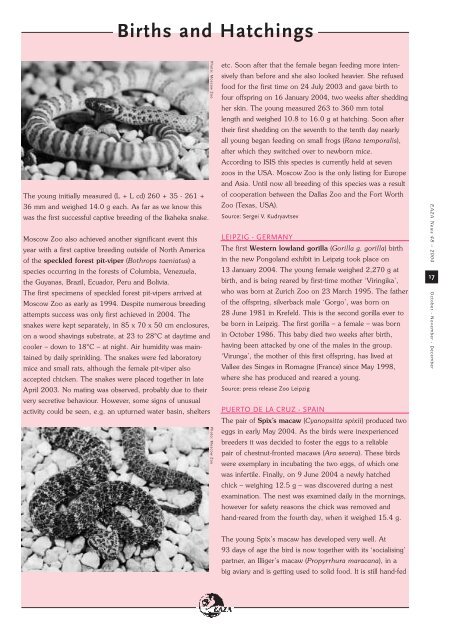EAZA NEWS 48 - European Association of Zoos and Aquaria
EAZA NEWS 48 - European Association of Zoos and Aquaria
EAZA NEWS 48 - European Association of Zoos and Aquaria
You also want an ePaper? Increase the reach of your titles
YUMPU automatically turns print PDFs into web optimized ePapers that Google loves.
The young initially measured (L + L cd) 260 + 35 - 261 +<br />
36 mm <strong>and</strong> weighed 14.0 g each. As far as we know this<br />
was the first successful captive breeding <strong>of</strong> the Ikaheka snake.<br />
Moscow Zoo also achieved another significant event this<br />
year with a first captive breeding outside <strong>of</strong> North America<br />
<strong>of</strong> the speckled forest pit-viper (Bothrops taeniatus) a<br />
species occurring in the forests <strong>of</strong> Columbia, Venezuela,<br />
the Guyanas, Brazil, Ecuador, Peru <strong>and</strong> Bolivia.<br />
The first specimens <strong>of</strong> speckled forest pit-vipers arrived at<br />
Moscow Zoo as early as 1994. Despite numerous breeding<br />
attempts success was only first achieved in 2004. The<br />
snakes were kept separately, in 85 x 70 x 50 cm enclosures,<br />
on a wood shavings substrate, at 23 to 28°C at daytime <strong>and</strong><br />
cooler – down to 18°C – at night. Air humidity was maintained<br />
by daily sprinkling. The snakes were fed laboratory<br />
mice <strong>and</strong> small rats, although the female pit-viper also<br />
accepted chicken. The snakes were placed together in late<br />
April 2003. No mating was observed, probably due to their<br />
very secretive behaviour. However, some signs <strong>of</strong> unusual<br />
activity could be seen, e.g. an upturned water basin, shelters<br />
Births <strong>and</strong> Hatchings<br />
Photo: Moscow Zoo<br />
Photo: Moscow Zoo<br />
etc. Soon after that the female began feeding more intensively<br />
than before <strong>and</strong> she also looked heavier. She refused<br />
food for the first time on 24 July 2003 <strong>and</strong> gave birth to<br />
four <strong>of</strong>fspring on 16 January 2004, two weeks after shedding<br />
her skin. The young measured 263 to 360 mm total<br />
length <strong>and</strong> weighed 10.8 to 16.0 g at hatching. Soon after<br />
their first shedding on the seventh to the tenth day nearly<br />
all young began feeding on small frogs (Rana temporalis),<br />
after which they switched over to newborn mice.<br />
According to ISIS this species is currently held at seven<br />
zoos in the USA. Moscow Zoo is the only listing for Europe<br />
<strong>and</strong> Asia. Until now all breeding <strong>of</strong> this species was a result<br />
<strong>of</strong> cooperation between the Dallas Zoo <strong>and</strong> the Fort Worth<br />
Zoo (Texas, USA).<br />
Source: Sergei V. Kudryavtsev<br />
LEIPZIG - GERMANY<br />
The first Western lowl<strong>and</strong> gorilla (Gorilla g. gorilla) birth<br />
in the new Pongol<strong>and</strong> exhibit in Leipzig took place on<br />
13 January 2004. The young female weighed 2,270 g at<br />
birth, <strong>and</strong> is being reared by first-time mother ‘Viringika’,<br />
who was born at Zurich Zoo on 23 March 1995. The father<br />
<strong>of</strong> the <strong>of</strong>fspring, silverback male ‘Gorgo’, was born on<br />
28 June 1981 in Krefeld. This is the second gorilla ever to<br />
be born in Leipzig. The first gorilla – a female – was born<br />
in October 1986. This baby died two weeks after birth,<br />
having been attacked by one <strong>of</strong> the males in the group.<br />
‘Virunga’, the mother <strong>of</strong> this first <strong>of</strong>fspring, has lived at<br />
Vallee des Singes in Romagne (France) since May 1998,<br />
where she has produced <strong>and</strong> reared a young.<br />
Source: press release Zoo Leipzig<br />
PUERTO DE LA CRUZ - SPAIN<br />
The pair <strong>of</strong> Spix’s macaw (Cyanopsitta spixii) produced two<br />
eggs in early May 2004. As the birds were inexperienced<br />
breeders it was decided to foster the eggs to a reliable<br />
pair <strong>of</strong> chestnut-fronted macaws (Ara severa). These birds<br />
were exemplary in incubating the two eggs, <strong>of</strong> which one<br />
was infertile. Finally, on 9 June 2004 a newly hatched<br />
chick – weighing 12.5 g – was discovered during a nest<br />
examination. The nest was examined daily in the mornings,<br />
however for safety reasons the chick was removed <strong>and</strong><br />
h<strong>and</strong>-reared from the fourth day, when it weighed 15.4 g.<br />
The young Spix’s macaw has developed very well. At<br />
93 days <strong>of</strong> age the bird is now together with its ‘socialising’<br />
partner, an Illiger’s macaw (Propyrrhura maracana), in a<br />
big aviary <strong>and</strong> is getting used to solid food. It is still h<strong>and</strong>-fed<br />
<strong>EAZA</strong> News <strong>48</strong> – 2004<br />
17<br />
October - November - December
















